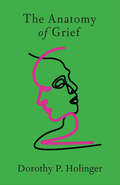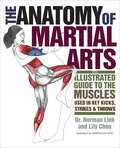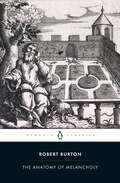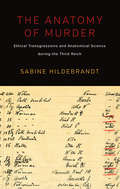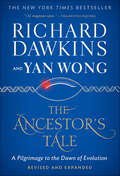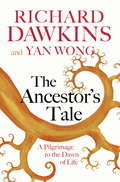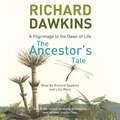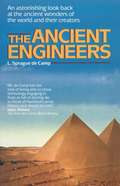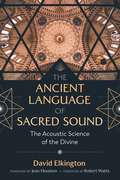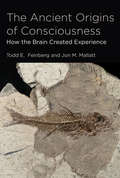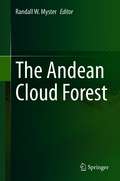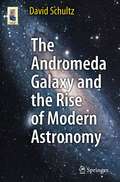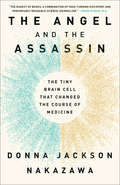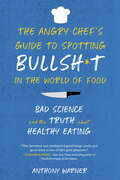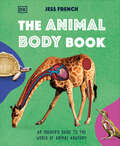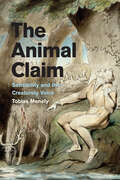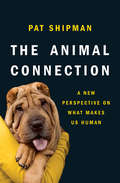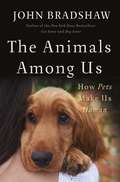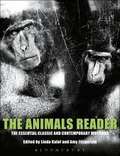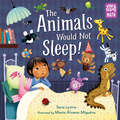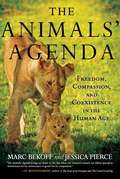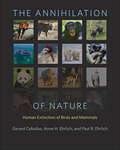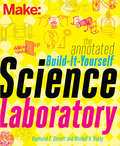- Table View
- List View
The Anatomy of Grief
by Dorothy P. HolingerAn original, authoritative guide to the impact of grief on the brain, the heart, and the body of the bereaved Grief happens to everyone. Universal and enveloping, grief cannot be ignored or denied. This original new book by psychologist Dorothy P. Holinger uses humanistic and physiological approaches to describe grief&’s impact on the bereaved. Taking examples from literature, music, poetry, paleoarchaeology, personal experience, memoirs, and patient narratives, Holinger describes what happens in the brain, the heart, and the body of the bereaved. Readers will learn what grief is like after a loved one dies: how language and clarity of thought become elusive, why life feels empty, why grief surges and ebbs so persistently, and why the bereaved cry. Resting on a scientific foundation, this literary book shows the bereaved how to move through the grieving process and how understanding grief in deeper, more multidimensional ways can help quell this sorrow and allow life to be lived again with joy. Visit the author's companion website for The Anatomy of Grief: dorothypholinger.com/
The Anatomy of Martial Arts: An Illustrated Guide to the Muscles Used for Each Strike, Kick, and Throw
by Lily Chou Norman G. LinkFor intermediate and advanced martial artists, a training reference highlighting the key muscle groups used for a variety of martial arts techniques.Unlock the power of the takedowns, strikes and defenses in martial arts from Kendo and Karate to Jiujitsu and Judo with this illustrated guide to the muscles and anatomy behind each movement.With detailed anatomical drawings, this book precisely illustrates the inner workings of your body during key martial arts moves. Its color drawings, helpful photos and clear text make it easy to identify the specific muscles you need to train for maximum speed, power and accuracy. More than just an anatomy book, each section is accompanied by exercises and stretches to strengthen muscles, prevent injury and improve form.•Kicks•Strikes•Takedowns•ThrowsThe Anatomy of Martial Arts is designed for a variety of disciplines, including:•Hapkido•Jiujitsu•Judo•Karate•Kendo•Kung Fu•Muay Thai•Taekwando
The Anatomy of Melancholy
by Robert Burton'The best book ever written' Nicholas Lezard, GuardianRobert Burton's labyrinthine, beguiling, playful masterpiece is his attempt to 'anatomize and cut up' every aspect of the condition of melancholy, from which he had suffered throughout his life. Ranging over beauty, digestion, the planets, alcohol, goblins, kissing, poetry and the restorative power of books, among many other things, The Anatomy of Melancholy has fascinated figures from Samuel Johnson to Jorge Luis Borges since the seventeenth century, and remains an incomparable examination of the human condition in all its flawed, endless variety.Edited with an introduction by Angus Gowland
The Anatomy of Murder
by Sabine HildebrandtOf the many medical specializations to transform themselves during the rise of National Socialism, anatomy has received relatively little attention from historians. While politics and racial laws drove many anatomists from the profession, most who remained joined the Nazi party, and some helped to develop the scientific basis for its racialist dogma. As historian and anatomist Sabine Hildebrandt reveals, however, their complicity with the Nazi state went beyond the merely ideological. They progressed through gradual stages of ethical transgression, turning increasingly to victims of the regime for body procurement, as the traditional model of working with bodies of the deceased gave way, in some cases, to a new paradigm of experimentation with the "future dead. "
The Ancestor's Tale: A Pilgrimage to the Dawn of Evolution
by Richard Dawkins Yan WongThe renowned biologist and thinker Richard Dawkins presents his most expansive work in this revised edition that offers a comprehensive look at evolution.Loosely based on the form of Chaucer's Canterbury Tales, Dawkins's tale takes us modern humans back through four billion years of life on our planet. As the pilgrimage progresses, we join with other organisms at the forty "rendezvous points" where we find a common ancestor. The band of pilgrims swells into a vast crowd as we join first with other primates, then with other mammals, and so on back to the first primordial organism.Dawkins's brilliant, inventive approach allows us to view the connections between ourselves and all other life in a bracingly novel way. It also lets him shed bright new light on the most compelling aspects of evolutionary history and theory: sexual selection, speciation, convergent evolution, extinction, genetics, plate tectonics, geographical dispersal, and more. The Ancestor's Tale is at once a far-reaching survey of the latest, best thinking on biology and a fascinating history of life on Earth. Here Dawkins shows us how remarkable we are, how astonishing our history, and how intimate our relationship with the rest of the living world.
The Ancestor's Tale: A Pilgrimage to the Dawn of Life
by Yan Wong Prof Richard DawkinsA fully updated edition of one of the most original accounts of evolution ever written, featuring new fractal diagrams, six new 'tales' and the latest scientific developments.THE ANCESTOR'S TALE is a dazzling, four-billion-year pilgrimage to the origins of life: Richard Dawkins and Yan Wong take us on an exhilarating reverse journey through evolution, from present-day humans back to the microbial beginnings of life. It is a journey happily interrupted by meetings of fellow modern animals (as well as plants, fungi and bacteria) similarly tracing their evolutionary path back through history. As each evolutionary pilgrim tells their tale, Dawkins and Wong shed light on topics such as speciation, sexual selection and extinction.Written with unparalleled wit, clarity and intelligence; taking in new scientific discoveries of the past decade; and including new 'tales', illustrations and fractal diagrams, THE ANCESTOR'S TALE shows us how remarkable we are, how astonishing our history, and how intimate our relationship with the rest of the living world.
The Ancestor's Tale: A Pilgrimage to the Dawn of Life
by Yan Wong Prof Richard DawkinsOne of the most brilliant scientists of our age gives us his definitive work: a synthesis of his comprehensive vision of life.THE ANCESTOR'S TALE is a pilgrimage back through time; a journey on which we meet up with fellow pilgrims as we and they converge on our common ancestors. Chimpanzees join us at about 6 million years in the past, orang utans at 14 million years, as we stride on together, a growing band. The journey provides the setting for a collection of some 40 tales. Each explores an aspect of evolutionary biology through the stories of characters met along the way. The tales are interspersed with prologues detailing the journey, route maps showing joining lineages, and life-like reconstructions of our common ancestors. THE ANCESTOR'S TALE represents a pilgrimage on an unimaginable scale: our goal is four billion years away, and the number of pilgrims joining us grows vast - ultimately encompassing all living creatures. At the end of the journey lies something remarkable in its simplicity and transformative power: the first, humble, replicating molecules.Read by Richard Dawkins and Lalla Ward(p) 2005 Orion Publishing Group
The Ancestor's Tale: A Pilgrimage to the Dawn of Life
by Richard Dawkins Yan WongA fully updated edition of one of the most original accounts of evolution ever written, featuring new fractal diagrams, six new 'tales' and the latest scientific developments.THE ANCESTOR'S TALE is a dazzling, four-billion-year pilgrimage to the origins of life: Richard Dawkins and Yan Wong take us on an exhilarating reverse journey through evolution, from present-day humans back to the microbial beginnings of life. It is a journey happily interrupted by meetings of fellow modern animals (as well as plants, fungi and bacteria) similarly tracing their evolutionary path back through history. As each evolutionary pilgrim tells their tale, Dawkins and Wong shed light on topics such as speciation, sexual selection and extinction.Written with unparalleled wit, clarity and intelligence; taking in new scientific discoveries of the past decade; and including new 'tales', illustrations and fractal diagrams, THE ANCESTOR'S TALE shows us how remarkable we are, how astonishing our history, and how intimate our relationship with the rest of the living world.
The Ancient Engineers: An Astonishing Look Back at the Ancient Wonders of the World and Their Creators
by L. Sprague de CampThe Pyramids of Giza, the Parthenon of Greece, the Great Wall of China, the Colosseum of Rome. Today, we stand in awe before these wonders of the ancient world. They hold our history and the deepest secrets of our past in their hidden recesses. In The Ancient Engineers, L. Sprague de Camp delves into the heart of the mystery. He introduces us to the master builders who had the vision, the power, and the passion to reach for the clouds and touch the heavens. We share in some of the greatest technological triumphs of all time--triumphs of the human mind, imagination, and spirit.
The Ancient Language of Sacred Sound: The Acoustic Science of the Divine
by David Elkington• Details how sacred sites resonate at the same frequencies as both the Earth and the alpha waves of the human brain • Shows how human writing in its original hieroglyphic form was a direct response to the divine sound patterns of sacred sites • Explains how ancient hero myths from around the world relate to divine acoustic science and formed the source of religion The Earth resonates at an extremely low frequency. Known as &“the Schumann Resonance,&” this natural rhythm of the Earth precisely corresponds with the human brain&’s alpha wave frequencies--the frequency at which we enter into and come out of sleep as well as the frequency of deep meditation, inspiration, and problem solving. Sound experiments reveal that sacred sites and structures like stupas, pyramids, and cathedrals also resonate at these special frequencies when activated by chanting and singing. Did our ancestors build their sacred sites according to the rhythms of the Earth? Exploring the acoustic connections between the Earth, the human brain, and sacred spaces, David Elkington shows how humanity maintained a direct line of communication with Mother Earth and the Divine through the construction of sacred sites, such as Stonehenge, Newgrange, Machu Picchu, Chartres Cathedral, and the pyramids of both Egypt and Mexico. He reveals how human writing in its original hieroglyphic form was a direct response to the divine sound patterns of sacred sites, showing how, for example, recognizable hieroglyphs appear in sand patterns when the sacred frequencies of the Great Pyramid are activated. Looking at ancient hero legends--those about the bringers of important knowledge or language--Elkington explains how these myths form the source of ancient religion and have a unique mythological resonance, as do the sites associated with them. The author then reveals how religion, including Christianity, is an ancient language of acoustic science given expression by the world&’s sacred sites and shows that power places played a profound role in the development of human civilization.
The Ancient Origins of Consciousness: How the Brain Created Experience
by Todd E. Feinberg Jon M. MallattHow consciousness appeared much earlier in evolutionary history than is commonly assumed, and why all vertebrates and perhaps even some invertebrates are conscious.How is consciousness created? When did it first appear on Earth, and how did it evolve? What constitutes consciousness, and which animals can be said to be sentient? In this book, Todd Feinberg and Jon Mallatt draw on recent scientific findings to answer these questions—and to tackle the most fundamental question about the nature of consciousness: how does the material brain create subjective experience? After assembling a list of the biological and neurobiological features that seem responsible for consciousness, and considering the fossil record of evolution, Feinberg and Mallatt argue that consciousness appeared much earlier in evolutionary history than is commonly assumed. About 520 to 560 million years ago, they explain, the great “Cambrian explosion” of animal diversity produced the first complex brains, which were accompanied by the first appearance of consciousness; simple reflexive behaviors evolved into a unified inner world of subjective experiences. From this they deduce that all vertebrates are and have always been conscious—not just humans and other mammals, but also every fish, reptile, amphibian, and bird. Considering invertebrates, they find that arthropods (including insects and probably crustaceans) and cephalopods (including the octopus) meet many of the criteria for consciousness. The obvious and conventional wisdom–shattering implication is that consciousness evolved simultaneously but independently in the first vertebrates and possibly arthropods more than half a billion years ago. Combining evolutionary, neurobiological, and philosophical approaches allows Feinberg and Mallatt to offer an original solution to the “hard problem” of consciousness.
The Andean Cloud Forest
by Randall W. MysterA book focused solely on Andean Cloud Forests (ACF) has never been published. ACF are high biodiversity ecosystems in the Neotropics with a large proportion of endemic species, and are important for the hydrology of entire regions. They provide water for large parts of the Amazon basin, for example. Here I take advantage of my many years working in ACF in Ecuador, to edit this book that contains the following sections: (1) ACF over space and time, (2) Hydrology, (3) Light and the Carbon cycle, (4) Soil, litter, fungi and nutrient cycling, (5) Plants, (6) Animals, and (7) Human impacts and management. Under this premise, international experts contributed chapters that consist of reviews of what is known about their topic, of what research they have done, and of what needs to be done in the future. This work is suitable for graduate students, professors, scientists, and researcher-oriented managers.
The Andromeda Galaxy and the Rise of Modern Astronomy
by David SchultzThe Andromeda Galaxy - Messier's M31 - has an almost romantic appeal. It is the most distant object and the only extragalactic object that is visible to the unaided human eye. Now known to be about 2½ million light-years away, it appears in the sky to be several times the width of the full Moon under good seeing conditions. The Andromeda Galaxy and the Rise of Modern Astronomy examines the astronomical studies of Andromeda and its importance to our developing knowledge of the universe. The book discusses how M31 was described both by the Ancients, but more importantly, by astronomers from the nineteenth century to the present. While at the start of the twentieth century the universe was thought of as a finite cosmos dominated by the Milky Way, the study of Andromeda galaxy shattered that image, leading ultimately to the conception of an infinite universe of countless galaxies and vast distances. Even today, M31 is a major focal point for new astronomical discoveries, and it also remains one of the most popular (and rewarding) celestial objects for amateur astronomers to observe and study. This book reveals the little-known history of M31 and the scientists who study it. For all who are interested in astronomy, the skies, and perhaps even the origins of the universe, The Andromeda Galaxy and the Rise of Modern Astronomy provides a first-of-its-kind accessible, informative, and highly readable account of how the study and observation of this celestial object has driven the development of astronomy from ancient times to the present.
The Angel and the Assassin: The Tiny Brain Cell That Changed the Course of Medicine
by Donna Jackson NakazawaA thrilling story of scientific detective work and medical potential that illuminates the newly understood role of microglia—an elusive type of brain cell that is vitally relevant to our everyday lives. &“The rarest of books: a combination of page-turning discovery and remarkably readable science journalism.&”—Mark Hyman, MD, #1 New York Times bestselling author of Food: What the Heck Should I Eat? Until recently, microglia were thought to be merely the brain&’s housekeepers, helpfully removing damaged cells. But a recent groundbreaking discovery revealed them to be capable of terrifying Jekyll and Hyde behavior. When triggered—and anything that stirs up the immune system in the body can activate microglia—they can morph into destroyers, impacting a wide range of issues from memory problems and anxiety to depression and Alzheimer&’s. Under the right circumstances, however, microglia can be coaxed back into being angelic healers, able to repair the brain in ways that help alleviate symptoms and hold the promise to one day prevent disease. A fascinating behind-the-scenes account of this cutting-edge science, The Angel and the Assassin also explores the medical implications of these game-changing discoveries. Award-winning journalist Donna Jackson Nakazawa began her investigation with a personal interest—when diagnosed with an autoimmune disorder years ago, she was convinced there was something physical going on in her brain as well as her body, though no doctor she consulted could explain how the two could be interacting in this way. With the compassion born of her own experience, she follows practitioners and patients on the front lines of treatments that help to &“reboot&” microglia—from neurofeedback and intermittent fasting to transcranial magnetic stimulation and gamma light flicker therapy. She witnesses patients finding significant relief from pressing symptoms—and at least one stunning recovery—offering new hope to the tens of millions who suffer from mental, cognitive, and physical health issues. Proving once and for all the biological basis for the mind-body connection, the discovery of the true role of microglia stands to rewrite psychiatric and medical texts as we know them. Hailed as &“riveting,&” &“stunning,&” and &“visionary,&” The Angel and the Assassin offers us a radically reconceived picture of human health and promises to change everything we thought we knew about how to heal ourselves.
The Angry Chef's Guide to Spotting Bullsh*t in the World of Food: Bad Science And The Truth About Healthy Eating
by Anthony WarnerJust say no to nutri-nonsense Why is Chef Anthony Warner so angry? Two words: pseudoscience bullshit. Lies about nutrition are repeated everywhere—in newspaper headlines, on celebrity blogs, even by our well-meaning friends and family. Bad science is no reason to give up good food (we miss you, bread)! It’s high time to distinguish fact from crap. As the Angry Chef, Warner skewers common food myths that range from questionable (“coconut oil is a weight-loss miracle”) to patently dangerous (“autism is caused by toxins”). He also cuts down a host of fad diets—including the paleo diet and the infamous detox. Warner goes on to explain why we’re so easily misled: It has a lot to do with our instinctive craving for simple explanations and straightforward rules. With help from “Science Columbo,” he pares away poisonous rhetoric and serves up the delicious, nuanced truth (with a side of saucy humor). Bon appétit!
The Angular Momentum of Light
by David L. Andrews Mohamed BabikerRecent developments in the angular momentum of light present fresh challenges to long established concepts and pave the way for new and wide-ranging applications. The scope for structured light such as optical vortices, in particular, now extends from microfluidics to quantum information. This is the first comprehensive edited collection dealing with light carrying spin and orbital angular momentum, covering both fundamental and applied aspects. Written by internationally leading specialists, the chapters have been compiled to reflect the latest scientific progress and to address the multitude of theoretical, experimental and technical issues associated with this vibrant and exciting field. The volume is an authoritative reference for academic researchers and graduate students engaged in theoretical or experimental study of optical angular momentum and its applications. It will also benefit professionals in physics, optics and optical engineering, chemistry and biology.
The Animal Body Book: An Insider's Guide to the World of Animal Anatomy
by Jess FrenchAnimals come in all shapes and sizes, and they are just as different on the inside as they are on the outside. Join children’s author and vet Dr. Jess French and explore how animal bodies work, and the amazing things they can do.Animals perform extraordinary feats every day, from breathing underwater to flying, but how do they do these amazing things? The answers lie in the miraculous forms and features of their bodies. Look under the skin of all sorts of animals to see how their different organs help them to survive and thrive. From a whale’s enormous heart and an owl’s sensitive ears to a tortoise’s tough shell and an insect’s unusual eyes, explore more than 40 animal adaptations in close detail. With nine chapters covering skeletons, circulation, digestion, the senses and more, every aspect of anatomy is covered, all clearly explained by animal expert Dr. Jess French. Stunning photography combined with cutaway illustrations reveal what each species looks like inside, and colorful diagrams help support understanding. The Animal Body Book is a friendly introduction to animal anatomy, perfect for any child fascinated by animals or budding veterinarians.
The Animal Claim: Sensibility and the Creaturely Voice
by Tobias MenelyDuring the eighteenth century, some of the most popular British poetry showed a responsiveness to animals that anticipated the later language of animal rights. Such poems were widely cited in later years by legislators advocating animal welfare laws like Martin’s Act of 1822, which provided protections for livestock. In The Animal Claim, Tobias Menely links this poetics of sensibility with Enlightenment political philosophy, the rise of the humanitarian public, and the fate of sentimentality, as well as longstanding theoretical questions about voice as a medium of communication. In the Restoration and eighteenth century, philosophers emphasized the role of sympathy in collective life and began regarding the passionate expression humans share with animals, rather than the spoken or written word, as the elemental medium of community. Menely shows how poetry came to represent this creaturely voice and, by virtue of this advocacy, facilitated the development of a viable discourse of animal rights in the emerging public sphere. Placing sensibility in dialogue with classical and early-modern antecedents as well as contemporary animal studies, The Animal Claim uncovers crucial connections between eighteenth-century poetry; theories of communication; and post-absolutist, rights-based politics.
The Animal Connection: A New Perspective on What Makes Us Human
by Pat ShipmanA bold, illuminating new take on the love of animals that drove human evolution. Why do humans all over the world take in and nurture other animals? This behavior might seem maladaptive--after all, every mouthful given to another species is one that you cannot eat--but in this heartening new study, acclaimed anthropologist Pat Shipman reveals that our propensity to domesticate and care for other animals is in fact among our species' greatest strengths. For the last 2.6 million years, Shipman explains, humans who coexisted with animals enjoyed definite adaptive and cultural advantages. To illustrate this point, Shipman gives us a tour of the milestones in human civilization-from agriculture to art and even language--and describes how we reached each stage through our unique relationship with other animals. The Animal Connection reaffirms our love of animals as something both innate and distinctly human, revealing that the process of domestication not only changed animals but had a resounding impact on us as well.
The Animals Among Us: How Pets Make Us Human
by John BradshawThe bestselling author of Dog Sense and Cat Sense explains why living with animals has always been a fundamental aspect of being human Pets have never been more popular. Over half of American households share their home with either a cat or a dog, and many contain both. This is a huge change from only a century ago, when the majority of domestic cats and dogs were working animals, keeping rodents at bay, guarding property, herding sheep. Nowadays, most are valued solely for the companionship they provide. As mankind becomes progressively more urban and detached from nature, we seem to be clinging to the animals that served us well in the past.In The Animals Among Us, anthrozoologist John Bradshaw argues that pet-keeping is nothing less than an intrinsic part of human nature. An affinity for animals drove our evolution and now, without animals around us, we risk losing an essential part of ourselves.
The Animals Reader: The Essential Classic and Contemporary Writings
by Linda Kalof Amy FitzgeraldThe study of animals - and the relationship between humans and other animals - is now one of the most fiercely debated topics in contemporary science and culture. Animals have a long history in human society, providing food, labour, sport and companionship as well as becoming objects for exhibit. More contemporary uses extend to animals as therapy and in scientific testing. As natural habitats continue to be destroyed, the rights of animals to co-exist on the planet - and their symbolic power as a connection between humans and the natural world - are ever more hotly contested. The Animals Reader brings together the key classic and contemporary writings from Philosophy, Ethics, Sociology, Cultural Studies, Anthropology, Environmental Studies, History, Law and Science. As the first book of its kind, The Animals Reader provides a framework for understanding the current state of the multidisciplinary field of animal studies. This anthology will be invaluable for students across the Humanities and Social Sciences as well as for general readers.
The Animals Would Not Sleep! (Storytelling Math #2)
by Sara LevineCelebrate diversity, math, and the power of storytelling!It's bedtime for Marco and his stuffed animals, but the animals have other ideas. When Marco tries to put them away, they fly, swim, and slither right out of their bins! Can Marco sort the animals so everyone is happy? A playful exploration of sorting and classifying that combines math with empathy. The perfect bedtime book, featuring Latinx characters and a note about scientific classification.Storytelling Math celebrates children using math in their daily adventures as they play, build, and discover the world around them. Joyful stories and hands-on activities make it easy for kids and their grown-ups to explore everyday math together. Developed in collaboration with math experts at STEM education nonprofit TERC, under a grant from the Heising-Simons Foundation.
The Animals' Agenda: Freedom, Compassion, and Coexistence in the Human Age
by Marc Bekoff Jessica PierceA compelling argument that the time has come to use what we know about the fascinating and diverse inner lives of other animals on their behalfEvery day we are learning new and surprising facts about just how intelligent and emotional animals are—did you know rats like to play and laugh, and also display empathy, and the ears and noses of cows tell us how they’re feeling? At times, we humans translate that knowledge into compassion for other animals; think of the public outcry against the fates of Cecil the lion or the captive gorilla Harambe. But on the whole, our growing understanding of what animals feel is not resulting in more respectful treatment of them.Renowned animal-behavior expert Marc Bekoff and leading bioethicist Jessica Pierce explore the real-world experiences of five categories of animals, beginning with those who suffer the greatest deprivations of freedoms and choice—chickens, pigs, and cows in industrial food systems—as well as animals used in testing and research, including mice, rats, cats, dogs, and chimpanzees. Next, Bekoff and Pierce consider animals for whom losses of freedoms are more ambiguous and controversial, namely, individuals held in zoos and aquaria and those kept as companions. Finally, they reveal the unexpected ways in which the freedoms of animals in the wild are constrained by human activities and argue for a more compassionate approach to conservation.In each case, scientific studies combine with stories of individual animals to bring readers face-to-face with the wonder of our fellow beings, as well as the suffering they endure and the major paradigm shift that is needed to truly ensure their well-being.The Animals’ Agenda will educate and inspire people to rethink how we affect other animals, and how we can evolve toward more peaceful and less violent ways of interacting with our animal kin in an increasingly human-dominated world.
The Annihilation of Nature: Human Extinction of Birds and Mammals
by Paul R. Ehrlich Anne H. Ehrlich Gerardo CeballosEnvironmental scientists reveal the victims of humanity’s massive assault on nature.Gerardo Ceballos, Anne H. Ehrlich, and Paul R. Ehrlich serve as witnesses in this trial of human neglect, where the charge is the massive and escalating assault on living things. Nature is being annihilated, not only because of the human population explosion, but also as a result of massive commercial endeavors and public apathy. Despite the well-intentioned work of conservation organizations and governments, the authors warn us that not enough is being done and time is short for the most vulnerable of the world's wild birds and mammals. Thousands of populations have already disappeared, other populations are dwindling daily, and soon our descendants may live in a world containing but a minuscule fraction of the birds and mammals we know today.The Annihilation of Nature is a clarion call for engagement and action. These outspoken scientists urge everyone who cares about nature to become personally connected to the victims of our inadequate conservation efforts and demand that restoration replace destruction. Only then will we have any hope of preventing the worst-case scenario of the sixth mass extinction.
The Annotated Build-It-Yourself Science Laboratory: Build Over 200 Pieces of Science Equipment!
by Raymond Barrett Windell OskayRaymond E. Barrett's Build-It-Yourself Science Laboratory is a classic book that took on an audacious task: to show young readers in the 1960s how to build a complete working science lab for chemistry, biology, and physics--and how to perform experiments with those tools. The experiments in this book are fearless and bold by today's standards--any number of the experiments might never be mentioned in a modern book for young readers! Yet, many from previous generations fondly remember how we as a society used to embrace scientific learning. This new version of Barrett's book has been updated for today's world with annotations and updates from Windell Oskay of Evil Mad Scientist Laboratories, including extensive notes about modern safety practices, suggestions on where to find the parts you need, and tips for building upon Barrett's ideas with modern technology. With this book, you'll be ready to take on your own scientific explorations at school, work, or home.
